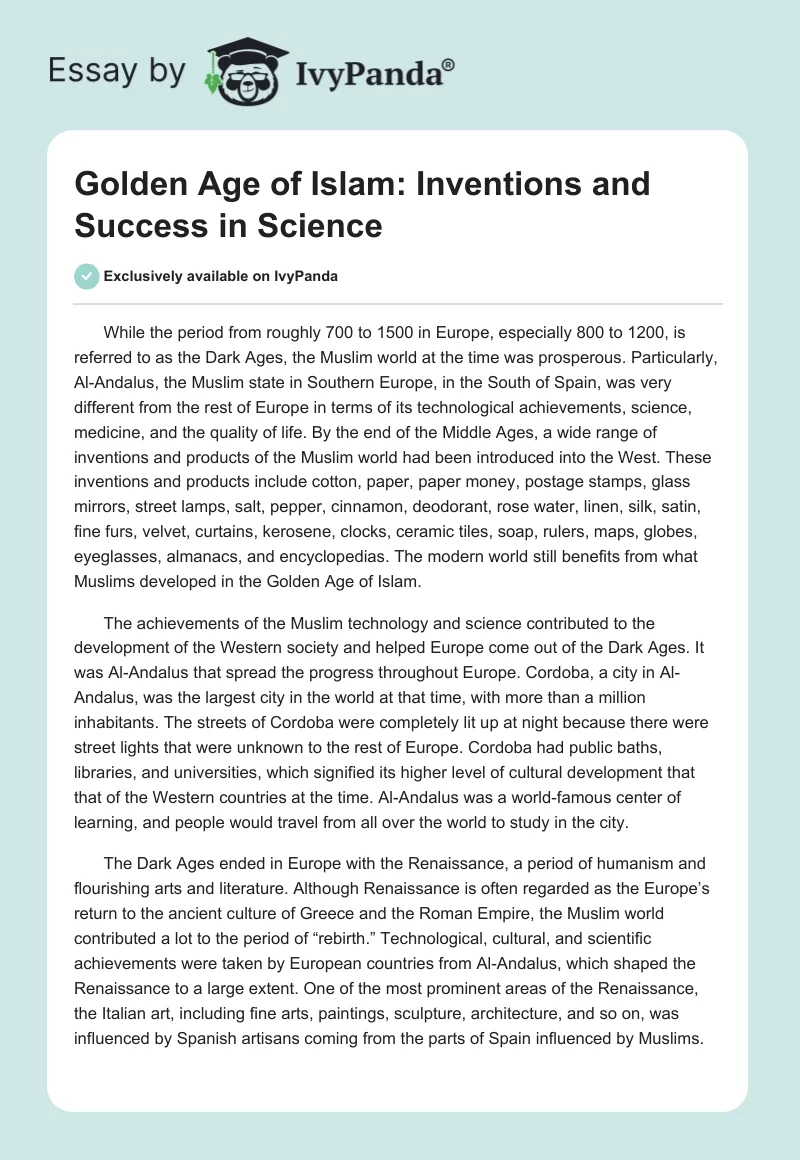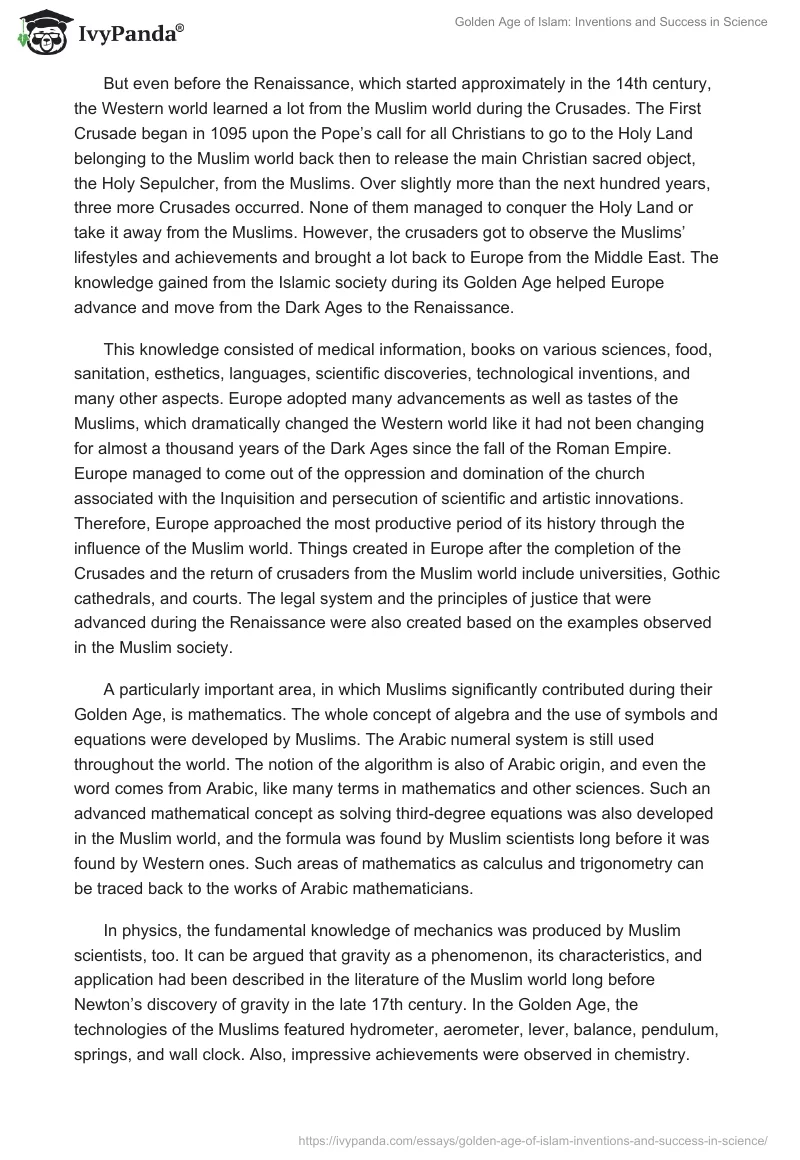While the period from roughly 700 to 1500 in Europe, especially 800 to 1200, is referred to as the Dark Ages, the Muslim world at the time was prosperous. Particularly, Al-Andalus, the Muslim state in Southern Europe, in the South of Spain, was very different from the rest of Europe in terms of its technological achievements, science, medicine, and the quality of life. By the end of the Middle Ages, a wide range of inventions and products of the Muslim world had been introduced into the West. These inventions and products include cotton, paper, paper money, postage stamps, glass mirrors, street lamps, salt, pepper, cinnamon, deodorant, rose water, linen, silk, satin, fine furs, velvet, curtains, kerosene, clocks, ceramic tiles, soap, rulers, maps, globes, eyeglasses, almanacs, and encyclopedias. The modern world still benefits from what Muslims developed in the Golden Age of Islam.
The achievements of the Muslim technology and science contributed to the development of the Western society and helped Europe come out of the Dark Ages. It was Al-Andalus that spread the progress throughout Europe. Cordoba, a city in Al-Andalus, was the largest city in the world at that time, with more than a million inhabitants. The streets of Cordoba were completely lit up at night because there were street lights that were unknown to the rest of Europe. Cordoba had public baths, libraries, and universities, which signified its higher level of cultural development that that of the Western countries at the time. Al-Andalus was a world-famous center of learning, and people would travel from all over the world to study in the city.
The Dark Ages ended in Europe with the Renaissance, a period of humanism and flourishing arts and literature. Although Renaissance is often regarded as the Europe’s return to the ancient culture of Greece and the Roman Empire, the Muslim world contributed a lot to the period of “rebirth.” Technological, cultural, and scientific achievements were taken by European countries from Al-Andalus, which shaped the Renaissance to a large extent. One of the most prominent areas of the Renaissance, the Italian art, including fine arts, paintings, sculpture, architecture, and so on, was influenced by Spanish artisans coming from the parts of Spain influenced by Muslims.
But even before the Renaissance, which started approximately in the 14th century, the Western world learned a lot from the Muslim world during the Crusades. The First Crusade began in 1095 upon the Pope’s call for all Christians to go to the Holy Land belonging to the Muslim world back then to release the main Christian sacred object, the Holy Sepulcher, from the Muslims. Over slightly more than the next hundred years, three more Crusades occurred. None of them managed to conquer the Holy Land or take it away from the Muslims. However, the crusaders got to observe the Muslims’ lifestyles and achievements and brought a lot back to Europe from the Middle East. The knowledge gained from the Islamic society during its Golden Age helped Europe advance and move from the Dark Ages to the Renaissance.
This knowledge consisted of medical information, books on various sciences, food, sanitation, esthetics, languages, scientific discoveries, technological inventions, and many other aspects. Europe adopted many advancements as well as tastes of the Muslims, which dramatically changed the Western world like it had not been changing for almost a thousand years of the Dark Ages since the fall of the Roman Empire. Europe managed to come out of the oppression and domination of the church associated with the Inquisition and persecution of scientific and artistic innovations. Therefore, Europe approached the most productive period of its history through the influence of the Muslim world. Things created in Europe after the completion of the Crusades and the return of crusaders from the Muslim world include universities, Gothic cathedrals, and courts. The legal system and the principles of justice that were advanced during the Renaissance were also created based on the examples observed in the Muslim society.
A particularly important area, in which Muslims significantly contributed during their Golden Age, is mathematics. The whole concept of algebra and the use of symbols and equations were developed by Muslims. The Arabic numeral system is still used throughout the world. The notion of the algorithm is also of Arabic origin, and even the word comes from Arabic, like many terms in mathematics and other sciences. Such an advanced mathematical concept as solving third-degree equations was also developed in the Muslim world, and the formula was found by Muslim scientists long before it was found by Western ones. Such areas of mathematics as calculus and trigonometry can be traced back to the works of Arabic mathematicians.
In physics, the fundamental knowledge of mechanics was produced by Muslim scientists, too. It can be argued that gravity as a phenomenon, its characteristics, and application had been described in the literature of the Muslim world long before Newton’s discovery of gravity in the late 17th century. In the Golden Age, the technologies of the Muslims featured hydrometer, aerometer, lever, balance, pendulum, springs, and wall clock. Also, impressive achievements were observed in chemistry. Muslims proposed the theory that all matter consisted of indivisible smallest portions of substance (atoms) and mastered the processes of crystallization, evaporation, filtration, and distillation, as well as their application to practical tasks. Many technologies of working with metal and dying fabrics and glass were invented during the Golden Age. Muslims discovered many chemicals and developed methods of preparing them and working with them, including sulfuric and nitric acids, chlorides and sulfides. This knowledge helped produce and actively use such things as soaps and perfumes, paints and gunpowder, glass, paper, and sugar.
Another area of outstanding achievements of the Muslim world during its Golden Age is geography and astronomy. Muslims invented astrolabes and celestial maps. They studied the shape of the Earth and suggested it was spherical, calculated the size (diameter and circumference) of the planet, and figured out the orbits of other planets and stars as well as the motion of the Earth around the Sun. For Muslims, the sense of direction was always important because they pray towards Mecca. This fact was the driving force for the development of geography and navigation. For example, the compass was invented. Also, cartography was an important science boosting the creation of maps and promoting the studies of winds and other phenomena that assist in navigation. Another reason for the development in these areas is the pilgrimage to Mecca, which every Muslim should undertake in their lifetime. This fact contributed to the development of roads, maps, and navigation techniques.
Finally, the Muslims gave to the world a lot of inventions and innovations in medicine. In Muslim countries, professional gynecologists and obstetricians appeared long before they did in the Western world. The patterns of blood circulation and pulmonary circulation were described in the Arabic medical literature of medieval times. Also, the mechanisms of communicable diseases and the processes of distribution of tuberculosis in particular by water and soil were described there, too, which is the origin of the branch of medicine called epidemiology. Muslims knew how to perform surgeries on teeth, eyes, ears, and other body parts. More than 200 surgical instruments and 143 types of medicines were described in Muslim medical and pharmacological books, which is much more than the European society used or was aware of in the Middle Ages.
Also, the urban infrastructure was highly developed in Cordoba and other large cities of the Muslim world. The engineers of Al-Andalus built aqueducts to carry the water from the mountains down to the inhabitants of the cities, providing every household with running water. In the present-day region of Spain that used to be a part of the Muslim world, the waterworks built back in the Golden Age of Islam is still functioning. Overall, the norms of sanitation adopted in the Muslim world, including changing clothes regularly, building sewage systems, and taking baths, were unknown to the West, which in a way caused several deadly epidemics in Europe in the Middle Ages.
Much of the refinement and advancement in the Western civilization of the end of the Middle Ages were brought from the Muslims. The Dark Ages of Europe, with underdeveloped technologies and science, were unfolding at the same time when the Muslim world was going through its Golden Age demonstrating outstanding achievements in a wide range of spheres of human activities.


